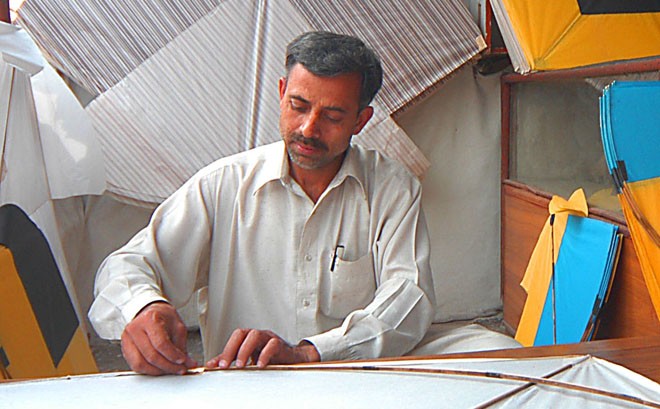
When exactly did we lose basant and what precisely do we want revived?

Other festivals may have lost their sheen because of this palpable threat to people’s security, with shrines and sportsmen and concerts being subjected to armed attacks and suicide bombers, but not quite so our basant.
In the years that basant transformed and became bigger, the kite-flying sport it had become associated with also became ‘bloodier’, slitting throats of people on motorbikes mostly. The media reported injuries and deaths at the top of its voice. Soon came the time to ban the ‘bloody sport’. The orders came either from the administration or the higher courts, often contradicting each other but without impacting the outcome -- the skies in Lahore shall remain empty of kites.
A friend pointed out last year that her seven year old daughter, born and brought up in Lahore, does not know what basant is. Shocking as this might seem, this February at year eight she won’t be any wiser on the subject. Another journalist friend took his tv cameras to the walled city to ask for ordinary people’s opinion on the ban, soon after it was imposed the first time. They held him by his collar and started shouting at him, saying it was he [referring to the media] who had taken "their basant away".
Before the ban, while the basant was turning into a huge big carnival, involving tourists both local and foreign, raising the turnover of this cottage industry by many times, critics had started questioning the direction it was taking. It was said that kite flying had become almost incidental to the festival. Yet, no sooner was kite flying thrown out, basant died too. The suggestions and some actual attempts in the form of official spring festivals to revive it, minus the kite flying part, fell dismally flat.
It becomes a tad difficult to pinpoint when exactly did we lose basant and what precisely do we want revived?
Till about thirty years ago, there was this simple flying of kites that came so naturally; the basant came somewhere in the middle of this kite flying season. But long before becoming this corportarised mega event where everyone, from the government to the corporate sector to the common people involved in the making of kite and twine, made money and long before the actual ban, the ordinary kite flyer lost this spirit to lose his kite to someone else. It became a sport that no side wanted to lose. Tandi, an aberration or foul-play for the serious kite flyer till then, became the norm and was in fact coated with chemicals to make it more lethal. The regular pinni or pinna could not hold it anymore; only a charkhi would.
Like many others around, those kite flyers, too, were looking for shortcuts. Who needs the skills required for a pecha when you have the right dor? The celebration and merry-making came at a cost that no one was ready to heed to at the time. The competition became cut-throat, literally.
The entire discourse around basant, that is only heard once every year around this time, has been reduced to two extreme either/or viewpoints, with one side struggling to reclaim this once festival of the soil and the other side silencing them for their insensitivity and disregard for human life.
Unfortunately, basant is not the only casualty; nuance is.
Also read: No season for fairs
It is considered a given that the government is unable to make it safe. The safety argument is potent as well as neutral enough to sidetrack the religious argument which is where the opposition to this festival always came from. People who wanted to celebrate it as a secular festival (perhaps the only one we had till Valentine’s Day came or did Valentine’s Day come as a replacement?) were told it was, in fact, ‘Hindu’ and what could be worse than that? This is what M.D. Tahir’s 2005 petition before the Lahore High Court, asking for banning of basant stated at the outset.
The religious groups that had decried basant for too long must be drawing vicarious pleasure out of this God-gifted ban.
As for those who want this joyful activity back in their lives, they can only curse their otherwise doer chief minister who took "their basant away" for fear of getting bad press.
Truth is the government did not seriously try. Truth also is that within Punjab, in other traditional kite-flying cities like Gujranwala, Sialkot, and Faisalabad, the sky is still dotted with colourful kites this time of the year while Lahore abstains or is made to. And should this not be also true that a government which is strong enough to get a ban implemented can equally ensure that kite-flying stays a safe sport.
Kite-flying continues in various cities across the border because the administration is constantly educating the people of the hazards involved. The government’s role is to regulate. Yusuf Salahuddin, a prominent Lahori who has a significant role in popularising this festival abroad, has some suggestions. To start with, he has offered a two-day basant in Lahore when three things should be banned -- motorcycles, charkhi and aerial firing. There is some wisdom in his request to the government to stay away from people’s basant and stop selling roads to the corporate sector.
Basant heralds spring and thereby celebrates life. As for kite-flying, it must mean a spirit to lose a kite or two. Together, they have as much potential as life itself. Can this be a time of joyous abandon again!